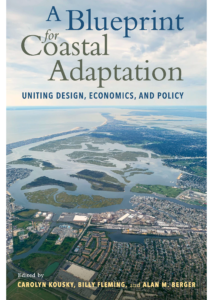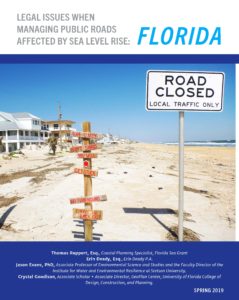No one-size-fits-all prescription for adapting to sea-level rise is possible for Florida’s coastal communities. For example, while a community may have a responsibility to inform people about coastal hazards such as storm surge and sea-level rise, the community will also want to encourage economic development and investment that makes the community vibrant and contributes to the tax base. Each community needs to assess for itself its vulnerabilities and how to find the balance between the many competing interests that present themselves in adaptation to sea-level rise and coastal planning generally. The following materials offer planners and attorneys materials to help them analyze the different planning and policy options for addressing sea-level rise and other coastal hazards.
Sea-Level Rise Adaptation and the Bert J. Harris, Jr., Private Property Rights Protection Act
The Bert J. Harris, Jr., Private Property Rights Protection Act was not developed or passed by Florida’s Legislature in 1995 with sea-level rise in mind. Even as major coastal disasters increase in frequency, scope and cost, human development choices continue to drive more of that increase than climate change and sea-level rise. While that dynamic will likely change in Florida sooner than in many parts of the county, our development choices are still a main driver of vulnerability. And the public and private development decisions that drive the creation of vulnerability also cost taxpayers billions, as we have seen from federal supplemental spending over the past several years as well as over $30 billion in loan forgiveness to the National Flood Insurance Program. A key potential way to decrease creation of additional vulnerability and adapt to climate change is to use the standard tools of community planning and land use regulation in coastal areas. However, according to conversations with local government attorneys, the Bert J. Harris Act has chilled the willingness of local governments to use the most powerful tools they have for preventing creation of risks that all taxpayers will have to pay for.
This article examines the Bert Harris Act as of early 2021, including early 2021 legislative proposals for changes to the Bert Harris Act. Research for the article included all reported appellate case law involving the act and some unreported case law. After an introduction to the Bert Harris Act, the article provides both procedural and substantive potential defenses for government entities sued under the Act and provides legal analysis of the potential defense. The article ends with some overarching conclusions and thoughts to help local governments address the significant risks of liabilities local governments face from the Bert Harris Act and avenues for local governments to still try to prevent creation of additional vulnerability and legal risk for the future.
A Blueprint for Coastal Adaptation Uniting Design, Economoics, and Policy
 Sea level rise will take some places from us. How will we clean up the residential areas we leave behind so that our coastlines are not foul, toxic, dangerous places? Who is responsible for cleaning up abandoned properties? How will this be funded? Why? What might an effective cleanup program look like? And could we really consider a program “effective” without that program integrating social justice, equity, and disparate impacts concerns (i.e., equitable resilience)? Are there models we can look to for insight on how to address these challenges? This analysis begins a conversation about these and related issues with the hope that we can plan with enough foresight to achieve cleanups that protect coastlines for future generations and allow at least some coastlines to evolve naturally with rising seas. And while rising seas motivated development of the ideas in this chapter, similarities to flooding challenges we face more generally also present themselves, and some of the work may apply there as well.
Sea level rise will take some places from us. How will we clean up the residential areas we leave behind so that our coastlines are not foul, toxic, dangerous places? Who is responsible for cleaning up abandoned properties? How will this be funded? Why? What might an effective cleanup program look like? And could we really consider a program “effective” without that program integrating social justice, equity, and disparate impacts concerns (i.e., equitable resilience)? Are there models we can look to for insight on how to address these challenges? This analysis begins a conversation about these and related issues with the hope that we can plan with enough foresight to achieve cleanups that protect coastlines for future generations and allow at least some coastlines to evolve naturally with rising seas. And while rising seas motivated development of the ideas in this chapter, similarities to flooding challenges we face more generally also present themselves, and some of the work may apply there as well.
Legal Issues When Managing Public Roads Affected by Sea Level Rise: Florida
Excerpt from the introduction: Coastal communities are increasingly becoming aware of the risks to their ecosystems, homes, and economies because of increased flooding, more extreme storm surges, and sea level rise. Reducing risk on the coast will be achieved by means of a variety of approaches, including policy and regulatory changes, natural resource protection, structural and non-structural intervention and investment, and retreat. A project team involving researchers, legal and policy experts, and law students have assisted coastal communities in four states – Florida, Georgia, South Carolina, and North Carolina – to prepare for present vulnerabilities and projected future conditions based on likely sea-level rise scenarios. This paper is part of the project’s objective to analyze legal and policy factors affecting adaptation responses, focusing on the state and local levels. Additional white papers associated with this project may be found at http://gacoast.uga.edu/.
Roads to Nowhere in Four States: State and Local Governments in the Atlantic Southeast Facing Sea-Level Rise
Excerpt from the introduction: This Article presents an analysis of coastal communities in four South Atlantic states—Florida, Georgia, South Carolina, and North Carolina—that are currently facing questions about how to protect property and infrastructure as sea levels rise and flooding increases. This Article distills the findings of an interdisciplinary research project funded by the National Oceanic and Atmospheric Administration (“NOAA”), Florida Sea Grant, Georgia Sea Grant, South Carolina Sea Grant Consortium, and North Carolina Sea Grant. It also consists of a regional analysis comparing how tort and local government law can both further and hinder climate change resilience planning and climate adaptation efforts across these four states. Given that the federal government has offered little in terms of legislation, policy, or funding to direct or support climate adaptation activities, local efforts—and the litigation that inevitably results—are on the forefront of establishing the framework for defining adaptation policy more broadly and influencing the contours of tort and land use law. This Article, therefore, fills an important research gap in existing climate change literature, as it discusses how increased flooding at the local level is putting pressure on traditional conceptions of government duties, immunities, and authorities. This Article also uses roads as a case study to explore how sea-level rise is altering planning, maintenance, and funding for public infrastructure.
Castles–and Roads–In the Sand: Do All Roads Lead to a “Taking”?
The law has been slow to acknowledge to the unprecedented nature of sea-level rise. Unless and until the law adapts, past case law on coastal hazards exacerbated by sea-level rise provide the best guidance. This article critically examines a seminal Florida case that addressed local government liability for coastal erosion damage to a road and dramatically altered Florida law in two key respects. First, the case altered and expanded the concept of “maintenance” of road infrastructure by a local government as the baseline duty that must be met to avoid potential legal liability. This occurred through flawed interpretation of prior case law. Second, the case introduced into Florida law the controversial idea that “inaction” may support a Fifth Amendment takings claim. The article traces how other courts have unwittingly or carelessly introduced “inaction” into their takings jurisprudence and evaluates whether and when inaction should be sufficient basis for a takings claim. The article draws out serious policy implications of the case in light of sea-level rise, and makes recommendations to address the fallout from the case.
Sea-Level Rise and Infrastructure: A Challenge for Local Government
For those seeking a condensed version of discussion about sea-level rise, infrastructure, and legal liability for local governments, the article “Sea-Level Rise and Infrastructure: A Challenge for Local Government” provides an overview of many issues addressed in more depth by other resources on this page.
Mana ging Property Buyouts at the Local Level: Seeking Benefits and Limiting Harms
ging Property Buyouts at the Local Level: Seeking Benefits and Limiting Harms
Efforts to conduct buyouts of at-risk properties represent an increasingly popular resilience tool, especially in response to massive flooding losses in recent years and the financial predicament and fiscal unsustainability of the National Flood Insurance Program. Buyouts often receive support as the least-cost option for dealing with the costs of flooding. Calls for buyouts increased after Superstorm Sandy hit the northeast United States, with both New York and New Jersey dedicating funds related to Sandy to voluntary buyout programs. In some communities where buyouts occur, an exclusive focus on the vulnerability of individual properties may lead to an implementation that also causes harm to neighborhoods and communities. In response to news articles pointing out the challenges and occasional issues with voluntary buyout programs, the authors collaborated in legal analysis and development of a model local government ordinance for Florida communities that would guide how communities participate in and support buyout implementation within their boundaries to seek to achieve the benefits of reduced flood risk while avoiding the most negative impacts of buyouts on communities. Legal research indicated the need for careful drafting due to federal and state requirements; such requirements indicate a need for targeted exemptions from local government policy limiting local government support for and implementation of specific federal or state buyout programs.
Questions and Answers About Flood Insurance
Not sure where to start with purchasing flood insurance for your home? This new frequently asked questions guides answers any questions you might have about the National Flood Insurance Program in an easy-to-read format.
No Adverse Impact: Floodplain Management Tools from the Association of State Floodplain Managers
For over 100 years flood losses in the United States have continued to climb every decade. Increasing population and development in at-risk areas started this trend, and climate change and sea-level rise now exacerbate it. The Association of State Floodplain Ma nagers has developed an extensive suite of tools to help local governments identify and understand policies they may implement at the local level to prevent increasing flood losses by focusing policy on development that has “No Adverse Impact” on existing development and existing flood risk.
nagers has developed an extensive suite of tools to help local governments identify and understand policies they may implement at the local level to prevent increasing flood losses by focusing policy on development that has “No Adverse Impact” on existing development and existing flood risk.
Environmentally Compromised Road Segments—A Model Ordinance
The legal case of Jordan v. St. Johns County, Case No. CA05-694 (Fla. 7th Jud. Cir. May 21, 2009), aff’d in part, rev’d in part by Jordan v. St. Johns County, 63 So. 3d 835, 837 (Fla. 2011), brought into stark relief for local governments in Florida the physical, legal, and financial dangers of coastal hazards. The model ordinance presented here developed from a concern about how erosion, and other coastal hazards being exacerbated by sea-level rise, present serious legal and financial challenges for local governments. This ordinance seeks to provide a framework in which local governments can balance their interest in protecting property rights and access to property while also acknowledging that fiscal responsibility and limited resources may counsel limiting expenditures in some instances.
Sea-Level Rise Adaptation Financing at the Local Level in Florida
Adaptation to sea-level rise is already proving itself an expensive endeavor. The City of Miami Beach has embarked on a project to raise roads and replace gravity-flow drainage systems with pumps and valves–at a cost estimated to reach between $400 and $500 million for the multi-year project. How can local governments pay for such expensive infrastructure work? While some funds may come through state or federal government through grants or as part of related projects for infrastructure belonging to state and federal government, much of the cost will be borne by local governments.This paper examines some of the most likely candidates for funding mechanisms that local governments may use for adapting to sea-level rise, as well as the strengths and weaknesses of each approach.
The Link Between Future Flood Risk and Comprehensive Planning
Comprehensive planning has formed a key part of community management in Florida for decades. This article traces some recent history as Florida begins to consider climate change and sea-level rise in comprehensive planning. The article then goes on to examine a new law in Florida that requires consideration of sea-level rise, among other flooding hazards, in the coastal management element of local comprehensive plans. Next the article discusses implementation issues with the new Florida law, considers how the National Flood Insurance Program and its related Community Rating System program include sea-level rise, and looks at federal policy initiatives that include sea-level rise, such as U.S. Army Corps of Engineers policy, the National Environmental Policy Act, and the Federal Flood Risk Management Standard. Overall, the article argues that local governments should piece together the bigger picture from all of these laws, policies, programs, and regulations and holistically plan for sea-level rise and flood risk to address them all. (article begins on page 7 of the pdf linked to in the title to this paragraph)
Drowning in Place: Local Government Costs and Liabilities for Flooding Due to Sea-Level Rise
This article, published in the November 2013 issue of the Florida Bar Journal, discusses the potential legal liabilities and context for local government maintenance and upgrading of drainage system in response to decreasing efficacy of such systems due to sea-level rise. The article concludes that in Florida it is likely that whether a local government will be liable for failure of a drainage system to keep properties drained in the face of sea-level rise will hinge on the legal determination of whether such flooding is ascribed to a failure to maintain or a failure to upgrade the drainage system. While the analysis in the article focuses specifically on Florida law, it appears that the reasoning and much of the law may be similar in other states.
Legal Considerations Surrounding Adaptation to the Threat of Sea Level Rise, City of Coral Gables
This document takes a broad look at the challenges that sea-level rise presents to the City of Coral Gables in southeast Florida. The document contains sections on Gathering Actionable Data, Informing and Engaging the Public, City Infrastructure Adaptations, Financing Sea Level Rise Adaptation Costs, Comprehensive Planning for Sea Level Rise, Regulatory Tools for Adaptation, Land Acquisitions and Conservation Easements, Market-Based Tools, and Long-Term Retreat.
and Long-Term Retreat.
What Will Adaptation Cost?
Adaptation to sea-level rise is a complex–and costly–issue for local governments. Local governments will not have sufficient funds to undertake activities that keep all property owners satisfied if even the more modest increases in sea-level rise occur. Thus, those engaged in adaptation have increasingly sought to understand what types of adaptations give the most “bang for the buck” when adapting to sea-level rise. A cost-benefit analysis of adaptation options presents great challenges as there are questions of scope of the costs and benefits, timing, amount of projected sea-level rise, multiple adaptation options, possible opportunity costs, and other variables. A report commissioned by the Coastal Services Center of NOAA developed a report that provides a framework for conducting a cost-benefit analysis that will help local decision makers focus their inquiries into the costs–and benefits–of different adaptation options.
 “Rolling Easements,” James G. Titus, Climate Ready Estuaries Program, and U.S. Environmental Protection Agency (June 2011)
“Rolling Easements,” James G. Titus, Climate Ready Estuaries Program, and U.S. Environmental Protection Agency (June 2011)
This detailed document offers a thorough and detailed introduction to the concept of a rolling easements. This primer defines what a rolling easement is, gives examples of how rolling easements may function, looks at ways of creating them, and many other specifics for design and use of rolling easements. This document itself recognizes its own limitation in that it is a national-level document. Thus, while it sometimes presents examples from states, the document is not designed to evaluate state property law. As a beginning point in evaluating rolling easements in Florida, this document may be combined with the resource “Use of Future Interests in Land as a Sea-Level Rise Adaptation Tool.”
Adaptation Tool Kit: Sea-Level Rise and Coastal Land Use
This document covers four broad areas of tools that local governments can use to adapt to sea-level rise: 1)Planning tools, 2) Regulatory tools, 3) Spending tools, and 4) Tax and Market-based tools. While it is not specific to Florida, the broad overview it provides is worthwhile.
Sea-Level Rise Ready: Model Comprehensive Plan Goals, Objectives, and Policies to Address Sea-Level Rise Impacts in Florida
For decades Florida has been known for its careful land use planning system. Even after numerous changes in 2011, such as decreasing the role of state review of local comprehensive plans, Florida local governments continue to have powerful tools for realizing a community’s vision of itself. Land use planning through a local government’s comprehensive plan remains one of the best ways for a local government to begin to address coastal hazards such as sea-level rise. The University of Florida Levin College of Law’s Conservation Clinic, working with the Charlotte Harbor Estuary Program and with support from Florida Sea Grant, developed model comprehensive plan goals, objectives, and policies which can help local governments envision ways in which their comprehensive plan can help them adopt to sea-level rise. The model goals, objectives, and policies are available in a PowerPoint® presentation here.
This very short document divides elevation strategy into elevation of land area and elevation of structures and highlights a few of the issues with each, including likely legal stumbling blocks.
Reasonable Investment-Backed Expectations: Should Notice of Rising Seas Lead to Falling Expectations for Coastal Property Purchaser?
This article, published in Volume 26 of the Journal of Land Use & Environmental Law, delves into the concept of “reasonable, investment-backed expectations in federal takings law. This leads into analysis of the importance of “notice” in evaluation of reasonable, investment-backed expectations. The importance of notice—and issues of fairness and personal responsibility—coalesce to support the idea that local governments could institute notice or disclosure ordinances for coastal hazards. The article cites to examples of disclosure or notice in other contexts and makes recommendations for drafting of a local notice ordinance.
Florida’s Coastal Hazards Disclosure Law: Property Owner Perceptions of the Physical and Regulatory Environment
This document contains research, findings, and recommendations related to Florida’s current coastal disclosure statute. This statute requires that potential purchasers of coastal property that is seaward of the Coastal Construction Line receive certain information about the dynamics of coastal property and regulations such as the Coastal Construction Control Line that impact uses of property. Research indicated that the current law is not accomplishing its stated goal, so the document addresses shortcomings in the statute by offering proposed statutory revisions. These revisions reflect the legal analysis in the above document “Reasonable Investment-Backed Expectations: Should Notice of Rising Seas Lead to Falling Expectation for Coastal Property Purchasers?”
Use of Future Interests in Land as a Sea-Level Rise Adaptation Strategy in Florida
This three-page document examines the prospects of using future interests in land for adaptation purposes in Florida. James Titus of the U.S. EPA has advocated for rolling easements for years, and his 2011 primer on the topic extensively treats the possibility of using future interests in land to implement the rolling easement concept. Specifics in Florida law present serious difficulties that likely mean future interests present less viable, flexible options than conservation/environmental easements in Florida.
Local Government Legal Workshop Presentations and Agendas
This links to a page with agendas and presentations from the local government adaptation workshops Florida Sea Grant has organized in conjunction with local partners.


